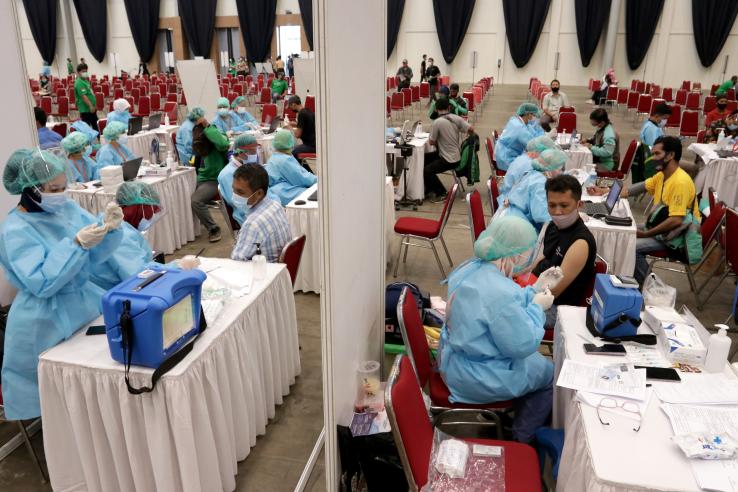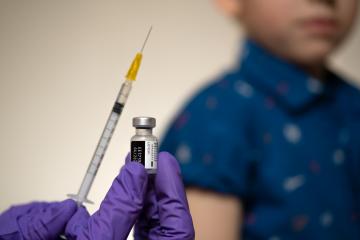
Strengthening Covid-19 immunization demand: Lessons from existing evidence

Please note: This document was prepared by the J-PAL Health sector to provide recommendations for addressing Covid-19 immunization. It is not an exhaustive review of all the rigorous evidence on the discussed topics.
Last updated: January 2023
Vaccines are one of the most impactful and cost-effective public health commodities, responsible for protecting millions of people every year against various infectious diseases such as polio, measles, and, most recently, Covid-19.1 Despite major accomplishments, Covid-19 vaccine campaigns continue to face challenges as of early 2023–two years after the first vaccines were approved. Coverage remains low globally, especially in low- and middle-income countries with only 26.4 percent of people in low-income countries having received at least one dose of the vaccine while high-income countries have 79.7 percent coverage as of January 2023.2
Many governments, global health organizations, civil society members, and more have ramped up, and tried to sustain, Covid-19 vaccination efforts with an eye toward reducing hospitalizations and deaths. COVAX, coordinated by Gavi, the Vaccine Alliance, the Coalition for Epidemic Preparedness Innovations, and the World Health Organization (WHO), has served as a groundbreaking global effort to accelerate the development, production, and equitable distribution of the vaccines. Building off the work of COVAX, the Covid-19 Vaccine Delivery Partnership, launched in early 2022, focuses on accelerating vaccine coverage in the countries with the lowest vaccination rates.3 As of January 2023, 13.24 billion doses of Covid-19 vaccines have been administered globally.4
Inequitable distribution of vaccines globally has prevented widespread access to Covid-19 vaccines, particularly in many low- and middle-income countries.5,6 In many instances, vaccine hesitancy or refusal is also present.7,8,9,10,11 Vaccination campaigns should not only account for logistics and service delivery challenges but also aim to strengthen the public’s demand for Covid-19 immunization.12
This note provides an overview of policy lessons stemming from economic research on improving Covid-19 immunization coverage and focuses on strategies to strengthen demand. For lessons on increasing routine child immunization coverage, please see the brief available here.
This note does not tailor recommendations to specific contexts or provide details on implementation. Rather, we encourage policymakers to reach out to Emily Blagg, a senior policy associate with J-PAL's Health sector, for follow-up conversations on incorporating the evidence into policy decisions.
Strengthening immunization demand
Even when vaccines are readily available and provided free of charge, several factors may make it difficult for caregivers to vaccinate their children or for adults to get vaccinated against Covid-19. Such barriers include lack of or inaccurate information, lack of trust, the low private benefits of immunization relative to the overall societal gains from herd immunity, and behavioral biases. Well-designed information campaigns, nudges, small incentives, and trust-building policies can address these barriers and increase demand for immunizations.
Providing accurate and clear information to promote better health can over overcome low demand
People may not be willing to seek out health services or take up preventive behaviors because of a lack of accurate information, information not being salient, or entrenched social norms. Information provision can help in overcoming these barriers to uptake of health products and services. In the case of Covid-19, information provision may be especially important given the novelty of the disease and associated treatments and vaccines.
- Providing information on the efficacy rates of a variety of different Covid-19 vaccine brands to vaccine-hesitant individuals in Latin America influenced13 their vaccine acceptance. Individuals informed of a low vaccine efficacy rate reduced their vaccine acceptance as compared to receiving no information, while those informed of a high efficacy rate had a higher self-reported likelihood of getting vaccinated. Furthermore, when both information on the producer and efficacy were provided, individuals’ self-reported willingness to get vaccinated decreased further for brands with lower efficacy, and increased for brands with higher efficacy.
- The same researchers conducted a second study in Latin America14 and found that receipt of basic information about Covid-19 vaccine safety and efficacy increased acceptance among the hesitant. Such information also reduced the self-reported time to wait to get vaccinated and increased willingness to encourage others to get vaccinated. These impacts appeared to be driven by reduced concerns about vaccine ineffectiveness, side effects, the speed of vaccine development, and the possibility of the vaccine giving individuals Covid-19.
- In Bangladesh15, over-the-phone counseling to address Covid-19’s mental health impacts that also included information sharing the disease’s symptoms and recommended preventive measures resulted in increased self-reported vaccination.
Peer influence can be leveraged to promote immunization
A large body of evidence from around the world shows that peers and community members can influence behavior.16 For immunization, peers can be leveraged to diffuse key logistical information such as when and where services are available or the presence of incentives, should those be in place. Spreading messages via peers can also increase demand by sharing information about the benefits of immunization or keeping immunization top of mind. Additionally, simply knowing that others in the community are engaging in certain health activities or adhering to preventive measures, like vaccination, may influence individuals to either act similarly and increase their willingness to get vaccinated, or it may have the opposite impact causing individuals to decrease their vaccine willingness and instead encourage them to “free ride” on the safety provided by others’ actions.
Policymakers may want to consider leveraging peers and other members of social networks to promote Covid-19 vaccination. Importantly, research on childhood immunizations has shown that simply asking a few community members to name well-connected individuals can be an inexpensive and accurate way to identify promising individuals to include in community-level immunization promotion.17
- In a large-scale Covid-19 survey from 23 countries occurring from October 2020 until March 2021, providing individuals information on the estimated vaccine acceptance reduced by 5.3 percent the fraction of people who are “unsure” or more negative about accepting a Covid-19 vaccine.
- Researchers conducted a study in Latin America18 on the impact of providing information about others’ intended vaccination behaviors. Such information increased self-reported willingness to vaccinate among the vaccine-hesitant when respondents expected herd immunity could be reached, rather than promoting free riding on the safety provided by others getting vaccinated, social conformity, or social learning about vaccines’ health benefits. Furthermore, social approval messages highlighting the respect an individual may garner from fellow community members by getting vaccinated also increased self-reported vaccination willingness.
- Another study in Latin America,19 found that awareness of the behaviors of peers was important–willingness to vaccinate among the vaccine-hesitant increased as population uptake increased suggesting either social learning, a desire for social conformity, or both. However, further research is needed to distinguish the individual roles of social learning, social conformity, and free riding.
Influential individuals can help spread key messages and combat misinformation
Because of larger networks, role modeling, ease of information sharing, and more, influential individuals, such as celebrities or experts, can help diffuse knowledge and combat misinformation on key health issues.20 However, influential individuals can also be a source of misinformation, and particularly polarizing or political individuals could potentially have negative impacts.
Policymakers may want to consider leveraging celebrity or expert outreach to increase knowledge about immunization. Knowledge about the importance of immunization is a critical step in motivating take-up; however, the extent to which increased knowledge translates into actual immunization improvements may be limited in contexts where other important barriers remain.
- In some contexts, medical experts may be more influential when compared with religious, political, and media elites. Across six Latin American countries,21 a study found that messages delivered by religious elites, local government authorities, or the media to vaccine-hesitant individuals resulted in lower reported willingness to get vaccinated compared to messages from medical experts.
Offering nudges to get immunized can help address behavioral biases and increase take-up
Nudges are light-touch interventions that address behavioral biases such as impatience, procrastination, or demand for convenience. They can help make immunization more salient and, in some cases, provide information. Nudges can take multiple forms, such as text message reminders and prompts at the pharmacy or doctor’s office. The design of nudges is particularly important for their efficacy.
Policymakers may want to consider using nudges for immunization to reach individuals who may be indifferent to immunization; however, they are unlikely to influence those who are hesitant or opposed to vaccines. For nudges providing information, specific and actionable guidance is important to promote behavioral change.22 Additional message framings, such as emphasis on prosocial behavior or personal benefits as well as nudge frequency, can also impact the effectiveness of information dissemination and nudges depending on the context.
- Framing in a way that makes the positive externality more salient may matter for Covid-19 vaccination. In nine countries in the Organisation for Economic Co-operation and Development,23 providing messages emphasizing social, health, or economic benefits, to survey respondents had a positive impact on intentions to get vaccinated immediately after exposure to such messaging. This persuasive effect persisted six months after the initial survey, translating into a higher probability of recipients reporting actually getting vaccinated.
- In the United States,24 persuasive messaging that framed vaccination as protecting others and a cooperative action increased intended uptake more than simple informational messages. Furthermore, these persuasive messages increased individuals’ stated willingness to persuade others and their negative judgments of non-vaccinators.
- Priming selective incentives to get vaccinated including social approval, altruism, and economic recovery were tested in six countries in Latin America.25 While social approval increased vaccine willingness and individuals’ likelihood of encouraging others to get vaccinated, priming economic motives had a marginal impact and altruistic motives had no impact.
- However, among a Medicaid managed care plan community in California, United States,26 an easy-to-use appointment scheduler system did not increase vaccination rates. The system allowed users to view available appointments without having to enter any personal data first aiming to make sign-up simpler.
Small incentives can increase demand for vaccines
Small incentives can help overcome behavioral biases such as procrastination and increase the immediate perceived benefit of receiving a vaccine.27 By improving immunization demand, these incentives can amplify the impact of investments in vaccine delivery. Although incentives may go to those who would have been vaccinated without incentives, in some contexts the cost per child has fallen when incentives were introduced by spreading fixed costs over a larger number of recipients.28
Policymakers may want to consider creating small incentives that signal progress through the immunization schedule. In the context of Covid-19, such progressive incentives could be especially relevant for multidose vaccines and recommended boosters. Small incentives are unlikely to overcome strong opposition to immunization but rather may be more effective for those who procrastinate, are ambivalent about being vaccinated, or are slightly hesitant to do so. However, incentives may, in some cases, actually decrease vaccination rates as the public might feel unwanted pressure to vaccinate or become skeptical of why they are being paid for a medical procedure. For instance, in the aforementioned California study,29 among vaccine-hesitant individuals presented with $10 or $50 financial incentives, those over forty years old became less likely to get vaccinated.
Addressing low confidence in the health system is critical to increase demand
Low confidence in health systems could stem from a variety of factors, including low-quality care, negative experiences with the health system, discrimination, or a lack of information.
Policymakers may want to consider implementing trust-building interventions to increase vaccine take-up in instances where marginalized groups may be less willing to get vaccinated or past events have undermined confidence in health care. Such policies will look different depending on the context but could include the ability to see health providers from the same race or implementing accountability mechanisms and other quality improvements. Given that low-quality care can contribute to low confidence in health systems, supply-side investments may have additional benefits to vaccine demand.30
- In the United States,31 videos promoting flu vaccination from nonexpert race-concordant individuals increased intent to get the flu and Covid-19 vaccines as well as self-reported flu vaccine take-up in 2019–2021 as compared to videos from medical doctors. The effects were concentrated among individuals with the least prior experience with vaccination. Nonexpert messengers could have been more effective because they were more proximate community members or because medical experts may have been seen as part of broader social interests or private interests such as insurers or pharmaceutical companies.
- Across six Latin American countries,32 citizens preferred Western-produced vaccines and their vaccine intentions were more influenced by trusted medical experts than political, religious, or media elite endorsements.
- Even in contexts where there is trust in the medical community, media reporting may create a narrative that there is a lack of consensus among experts. In the case of the Czech Republic33, ninety percent of study respondents initially underestimated doctors’ trust in Covid-19 vaccines, however, providing information about the true views of doctors recalibrated beliefs and led to a persistent increase in self-reported vaccine uptake.
Implementing multiple interventions together may maximize impact
The majority of these research studies test one type of intervention at a time without comparing these different interventions or testing them in combination with one another. Given the variety of barriers to vaccination, multiple interventions may be needed to maximize overall effectiveness, leading to the largest increase in immunization, however, additional research is needed on this topic.
- In Mozambique,34 researchers studied how to address three threats to Covid-19 vaccine acceptability–lack of information, low level of trust in the national health system’s capacity, and wide circulation of fake news. Researchers first tested a simple message endorsing vaccination. They then added a statement praising a previous successful immunization campaign that eradicated wild polio to evoke social memory and test whether the memory of an earlier achievement could increase the trust in the capacity to operationalize the vaccination campaign. Finally, they introduced a structured interaction with respondents to raise awareness of fake information about Covid-19, encourage a critical view towards misleading information, and minimize its sharing. They found that the combination of these three interventions increased vaccine acceptance as well as trust in institutions.
- In contrast, in the aforementioned study from California, United States,35 researchers partnered with Contra Costa Health Services to test the role of financial incentives, the lowering of appointment scheduling frictions, and provider messages on vaccine take-up in a racially and ethnically diverse Medicaid managed care population. Researchers found that while public health messages increased vaccination intention, none of the interventions increased vaccination rates, and among certain subgroups, financial incentives and gender-discordant messengers decreased vaccination rates.
This evidence note provides an overview of policy lessons stemming from the economic research thus far on improving Covid-19 vaccine coverage. However, there is still a need for further randomized evaluations on improving the availability and accessibility of vaccines as well as increasing their demand to inform policy decisions.
About J-PAL
The Abdul Latif Jameel Poverty Action Lab (J-PAL) is a global research center working to reduce poverty by ensuring that policy is informed by scientific evidence. Anchored by a network of more than 750 affiliated researchersStrengthening immunization demand and delivery: Lessons from existing evidence at universities around the world, J-PAL conducts randomized evaluations to answer critical questions in the fight against poverty. We build partnerships with governments, NGOs, donors, and others to share this knowledge, catalyze adoption of evidence at scale, and advance evidence-informed decision-making. J-PAL was launched at the Massachusetts Institute of Technology in 2003 and has regional centers in Africa, Europe, Latin America and the Caribbean, the Middle East and North Africa, North America, South Asia, and Southeast Asia.
- WHO and UNICEF, 2020; Our World in Data, 2020
- Mathieu, Edouard, Hannah Ritchie, Luca Rodés-Guirao, Cameron Appel, Charlie Giattino, Joe Hassel, Bobbie Macdonald, et al. 2020. “Coronavirus Pandemic (COVID-19),” Our World in Data, 2020.
- The Covid-19 Vaccine Delivery Partnership was launched by Gavi, the Vaccine Alliance, WHO, and UNICEF.
- Mathieu, Edouard, Hannah Ritchie, Luca Rodés-Guirao, Cameron Appel, Charlie Giattino, Joe Hassel, Bobbie Macdonald, et al. 2020. “Coronavirus Pandemic (COVID-19),” Our World in Data, 2020.
- Christopher Rowland, et al., “Drug Companies Defend Vaccine Monopolies in Face of Global Outcry,” The Washington Post, March 22, 2021, www.washingtonpost.com/business/2021/03/20/covid-vaccine-global-shortages/.
- “Covid: Europe's Vaccine Rollout 'Unacceptably Slow' – WHO,” BBC News, April 1, 2021, www.bbc.com/news/world-europe-56600660.
- Wouters et al., 2021
- Matina Stevis-Gridneff and Monika Pronczuk, “Worry Over 2 Covid Vaccines Deals Fresh Blow to Europe’s Inoculation Push” New York Times, April 13, 2021, https://www.nytimes.com/2021/04/13/world/europe/covid-vaccines-astrazeneca-johnson-johnson.html.
- Sheryl G. Stolberg and Annie Karni, “Nation Faces ‘Hand-to-Hand Combat’ to Get Reluctant Americans Vaccinated,” New York Times, April 28, 2021, https://www.nytimes.com/2021/04/21/us/politics/coronavirus-vaccine-rates.html.
- Rachel Treisman, “West Virginia Will Pay Young People $100 To Get Vaccinated Against Covid-19,” National Public Radio, April 27, 2021, https://www.npr.org/sections/coronavirus-live-updates/2021/04/27/991173625/west-virginia-will-pay-young-people-100-to-get-vaccinated-against-covid-19.
- Julia Dayton Eberwein, et al. “Key Drivers of Covid-19 Vaccine Hesitancy in Developing Countries.” World Bank Blogs, November 14, 2022, https://blogs.worldbank.org/developmenttalk/key-drivers-covid-19-vaccine-hesitancy-developing-countries?CID=WBW_AL_BlogNotification_EN_EXT.
- WHO, UNICEF, and World Bank, 2020
- Argote et al. 2021
- Argote Tironi et al. 2021
- Vlassopoulos et al. 2021
- For more on how peer effects and social networks can help to increase adoption of healthy behaviors, please see the J-PAL insight here.
- Banerjee et al. 2019
- Argote Tironi et al. 2021
- Argote et al. 2021
- Banerjee et al. 2020; Bowles et al. 2020; Alatas et al. 2020
- Argote et al. 2021
- For more on how specific and actionable information can help to increase adoption of healthy behaviors, please see the J-PAL insight here.
- Galasso et al. 2022
- James et al. 2021
- Argote Tironi et al. 2021
- Jacobson et al. 2022
- Policymakers may be concerned about introducing incentives for immunization for fear that they may increase the perceived risk of vaccination, reduce intrinsic motivation for those who had been willing to do it voluntarily, and/or reduce motivation in subsequent campaigns when incentives are not offered. However, more research is needed on these potential effects, and the evidence to date indicates incentives are a powerful means of increasing take-up in the short run.
- Banerjee et al. 2011
- Jacobson et al. 2022
- Christensen et al. 2021
- Alsan and Eichmeyer 2022
- Argote et al. 2021
- Bartos et al. 2022
- Armand et al. 2021
- Jacobson et al. 2022





